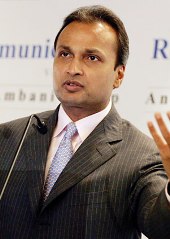 Anil Dhirubhai Ambani has moved quickly to monetise the peace dividend, after a new agreement with brother Mukesh Ambani of Reliance Industries.
Anil Dhirubhai Ambani has moved quickly to monetise the peace dividend, after a new agreement with brother Mukesh Ambani of Reliance Industries.
The ADA Group's recent decision to sell a stake in Reliance Communications and merge its telecom tower business with GTL Infra will help it reduce a mounting debt burden.
Capitaline data show that for the financial year ended March 31, 2009 (the latest available), ADAG's total debt shot up to Rs 67,562 crore (Rs 675.62 billion), compared with just Rs 27,442 crore (Rs 274.42 billion) two years ago.
During this period, operating cash flows remained stagnant at around Rs 10,000 crore (Rs 100 billion), implying the debt was more than six times the net cash generated from operating activities, and some 47 times the group's free cash flow.
However, the sale of the tower business to GTL Infrastructure and the subsequent stake sale would provide relief to the group.
Before the deal, the consolidated debt (post 3G) for RCom stood at Rs 33,000 crore (Rs 330 billion), around half the group's total debt.
The enterprise value as a percentage of Ebitda had grown in excess of four times, while that of its telecom sector peer, Bharti Airtel, stands at around two times.
According to analysts, the tower business (50,000 towers) could be valued at an EV per tower of around Rs 61 lakh (Rs 6.1 million), a 25 per cent premium over the Aircel and GTL deal.
The cash inflow into RCom is expected to be around Rs 18,000 crore (Rs 180 billion). This would substantially reduce its debt burden.
The additional 25 per cent dilution in RCom will bring in around Rs 10,000 crore (Rs 100 billion), reckon analysts.
That is the reason why ADAG stocks have been on fire. On an average, ADAG stocks have gained 40 per cent after the Ambani brothers announced their new agreement last month.
When contacted, an ADAG spokesperson said the debt numbers reported here 'do not reflect the correct picture' and the group would respond to an emailed questionnaire. But no response came despite several reminders, over five days.
While the overall debt to equity situation is stable, this is in part because of equity infusion in Reliance Power and the scheme of amalgamation that took place in 2008-09 in RCom, and not necessarily from cash generated from operations.
Under the scheme of amalgamation, Reliance Gateway Net Ltd, a wholly owned subsidiary of the company, amalgamated with RCom.
Subsequently, according to the annual report, the general reserve swelled by around Rs 27,000 crore (Rs 270 billion), in line with appropriate accounting norms.
The gross debt in the company, during the same period, also climbed by more than Rs 20,000 crore (Rs 200 billion).
The debt to equity ratio, which was 0.70:1 in the previous year, remained steady at around 0.82:1 in 2008-09. The numbers for 2009-10 are not available.
Under the scheme of amalgamation, Reliance Gateway Net Ltd, a wholly owned subsidiary of the company, amalgamated with RCom.
Subsequently, according to the annual report, the general reserve swelled by around Rs 27,000 crore (Rs 270 billion), in line with appropriate accounting norms. The gross debt in the company, during the same period, also climbed by more than Rs 20,000 crore (Rs 200 billion).
The debt to equity ratio, which was 0.70:1 in the previous year, remained steady at around 0.82:1 in 2008-09. The numbers for 2009-10 are not available.
The debt burden has become heavier because, as analysts point out, the scrapping of the memorandum of understanding with brother Mukesh Ambani and the Supreme Court ruling on gas pricing have reduced the profitability estimates for Reliance Power.
At the same time, the pricing war in the telecommunications business has seen profit margins shrink as average revenues per minute halved in the March 2010 quarter, from the first quarter of financial year 2009.
Reliance Power, at the moment, is a drag on the group's cash flow. It has an ambitious plan to take its power generation capacity to 35,000 Mw, from the current 1,000 Mw.
Details of the two prestigious ultra mega power plants at Krishnapatnam (4,000 MW) and Tilaiya (3,960 MW) are being worked out and financial closure is yet to be achieved.
Analysts reckon that, based on the capital cost norms and the UMPP guidelines of 70:30 debt to equity contribution, the debt requirement would be Rs 22,000 crore (Rs 220 billion) in the next two years.
Investment bankers said after the indifferent performance of the Reliance Power stock after the listing in February 2008, the sentiment for raising big funds from the public could not be very positive.
This is despite Anil Ambani announcing a bonus issue to get the acquisition price down.
On the positive side, say analysts, the Rs 10,000-crore (Rs 100-billion) debt and a debt to equity (stand-alone) ratio of 1.6 times in March 2010 of Reliance Capital compares well with the industry average of four to six times debt to equity ratio.
The management, in a recent conference call, had said that the insurance businesses would break even in the current financial year.
Also, the asset management business and consumer financing have caught up, but the company's profits have been largely through trading activities, which contributed to around 82 per cent of the profit before tax.
Other group companies like Reliance Infrastructure have seen steady cash generation.
According to a management statement, it has 24 projects worth Rs 37,000 crore (Rs 370 billion) lined up and would require funding for these as well.
It had around Rs 7,850 crore (Rs 78.5 billion) as cash on its books as on December 2009 and debt worth Rs 4,400 crore (Rs 44 billion).
Image: Anil Ambani






